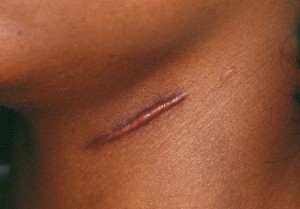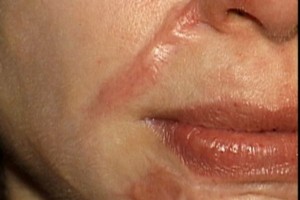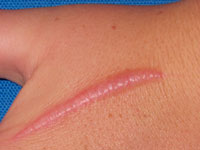Are you suffering from red, swollen scars on your skin? You may be having Hypertrophic Scars. Read on to know what is a Hypertrophic Scar, its causes, symptoms, diagnosis and treatment.
What Is Hypertrophic Scar?
Page Contents
- 1 What Is Hypertrophic Scar?
- 2 Hypertrophic Scar Symptoms
- 3 Causes of Hypertrophic Scar
- 4 Hypertrophic Scar Diagnosis
- 5 Hypertrophic Scar Treatment
- 6 Hypertrophic Scar Natural Treatment
- 7 Hypertrophic Scar Home Remedy
- 8 Hypertrophic Scar Pictures
- 9 Hypertrophic Scar Care
- 10 When Does Hypertrophic Scar Go Away?

Picture 1 – Hypertrophic Scar
Source – medscape
Hypertrophic Scar is a skin condition marked by accumulation of excess scar tissue in a localized region. The disease can affect individuals of any ethnic origin. It is, however, more common in black skinned people, Asians and Hispanics.
Hypertrophic Scar Symptoms
This condition is marked by the appearance of thick red scars on the skin surface. These usually arise only on skin regions that have been recently injured or operated on.
Hypertrophic Scars are different from Keloid Scars that grow indefinitely. Hypertrophic Scars only arise on the site of injury or surgery. The scars are thick and darker than the surrounding skin region. These usually arise on the ear lobes, lower facial area, shoulders, chest and back.
Hypertrophic Scars can develop at any time. These scrapes can arise even after a wound has healed on a skin region.
In later stages, the scars can turn itchy and painful. These become hard to touch and turn sensitive to changes in texture or temperature. Friction with clothes and rough surfaces can also cause pain and discomforts.
Causes of Hypertrophic Scar
The human body has its own natural way of healing. When the body suffers an injury, the cells produce a fibrous connective tissue known as Collagen and deposit it on the skin surface. It helps cover the wound and protect it from germs and other foreign materials. But in some cases, the collagen levels accumulated at the site of injury is higher. This gives rise to Hypertrophic Scars.
The higher accumulation of collagen occurs in response to certain events. These are :
Injections
Hypertrophic Scar formation often happens after certain strong medical injections.
Surgery
These scars are often seen to arise after a surgical operation. Many people are found to develop hypertrophic scar after surgery.
Injury
Hypertrophic pits are notable after the skin suffers a localized injury.
Acne
These scars are also often supposed to be the result of acne on the skin. In many sufferers of hypertrophic scar acne has been found to be a common causative factor.
Body Piercing
In many cases, Hypertrophic Scars arise after piercing of the skin surface. Body Piercing is one of the major Hypertrophic Scar causes.
Hypertrophic Scar Diagnosis
Hypertrophic Scars are mainly diagnosed by expert medical professionals by observing the physical appearance of the skin. In some cases, a skin biopsy may be needed to rule out presence of cancerous conditions such as tumors.
Hypertrophic Scar Treatment
Hypertrophic Scars are benign or non-dangerous skin growths and do not need any treatment. These usually resolve themselves over a period of time. However, treatment is necessary in case of discomforting symptoms like pain and itchiness. Medical cure is also required when the scars arise on areas like the face and neck affecting physical appearance.
Some effective ways of treatment for Hypertrophic Scar are
Laser Treatment
In people with Hypertrophic Scar laser treatment is found to be highly effective. In Hypertrophic Scar removal laser rays vaporize the upper scar tissues thereby exposing the skin layer underneath. It is one of the best Hypertrophic Scar treatments. Potent lasers can also enter the lower epidermal layers and promote growth of new collagen. Potent laser hypertrophic scar removal requires use of local anesthesia.
Cortisone Injections
In patients of Hypertrophic Scar injections of Cortisone make the scars go away. These injections pass intralesional steroids into the body that reduces the scars. These injections are painless and safe to administer.
Radiotherapy
Mild radiotherapy on the skin surface reduces redness of the scars and prevents their recurrence.
Surgery
In case of a severe scar, hypertrophic scar excision is the final way out. Methods like Z-plasty are found to be most effective in Hypertrophic Scar surgery.
Hypertrophic Scar Natural Treatment
Hypertrophic Scars can be naturally treated with the help of these methods.
Sandwalwood Paste Application
Mix black gram, sandalwood and a little water to make a paste. Apply this over the scar twice a day. This will help reduce the redness and swelling.
Ice Cube Press
Press ice cubes to the scar for 2-3 minutes, preferably thrice a day. This will bring down the inflammation and make the scars go away after some days.
Vitamin E Application
In patients of Hypertrophic Scar Vitamin E application has been found to yield effective results.
Cocoa Butter Application
Apply small amount of cocoa butter over the scars. Wash off this natural Hypertrophic Scar cream after 25-30 minutes.
Hypertrophic Scar Home Remedy
Want to try out hypertrophic scar home treatment methods? The following ways can be used for Hypertrophic Scar remedy at home.
Bromelain
Take 500 gm Bromelain capsules twice every day between meals. Bromelain is an enzyme obtained from Pineapple trees that reduces inflammation and decomposes excess materials surrounding the scars.
Calendula
Application of a calendula ointment twice a day over the scar helps it heal quickly. Calendula has anti-inflammatory properties and it helps reduce swelling in a Hypertrophic Scar.
Cottonwood
Combine 3 tsp Calendula Oil, 2 ½ tsp Cottonwood Oil and 6 tbsp. Petroleum Jelly. Apply this mixture over your scar at least twice a day. Regular application will shrink the scar in a month or two
Hypertrophic Scar Pictures
Want to check whether the red marks on your skin are Hypertrophic Scars? Check out these Hypertrophic Scar images. Know what does a Hypertrophic Scar look like.

Picture 2 – Hypertrophic Scar Image
Source – burnsurvivorsttw

Picture 3 – Hypertrophic Scar Photo
Source – 4-medic
Hypertrophic Scar Care
Hypertrophic Scar cure also consists of lifestyle and dietary modifications. A Hypertrophic Scar takes a long time to heal and it is best for you to try and avoid injuries to this area until it completely recovers. It is necessary to add Vitamin E and Vitamin C into the diet if you have Hypertrophic Scars. It is also advisable that you avoid oily and fatty foods. These increase secretion of sebum and makes oil glands more active.
When Does Hypertrophic Scar Go Away?
Hypertrophic Scar healing time is quite long. It generally takes anywhere from 12 to 18 months to heal naturally. With good hypertrophic scar management and treatment however, the scars can go away in 2-3 months.
If you are having a scar similar to this one, it is best to go for an early treatment. Hypertrophic Scar is not a dangerous condition but can take long to go away without cure. If you want to reduce hypertrophic scar fast, you should try medical options at the earliest.
References:
http://en.wikipedia.org/wiki/Hypertrophic_scar
http://www.wisegeek.com/what-is-a-hypertrophic-scar.htm
http://emedicine.medscape.com/article/876214-overview
https://health.google.com/health/ref/Keloids
http://www.wrongdiagnosis.com/medical/hypertrophic_scar.htm
